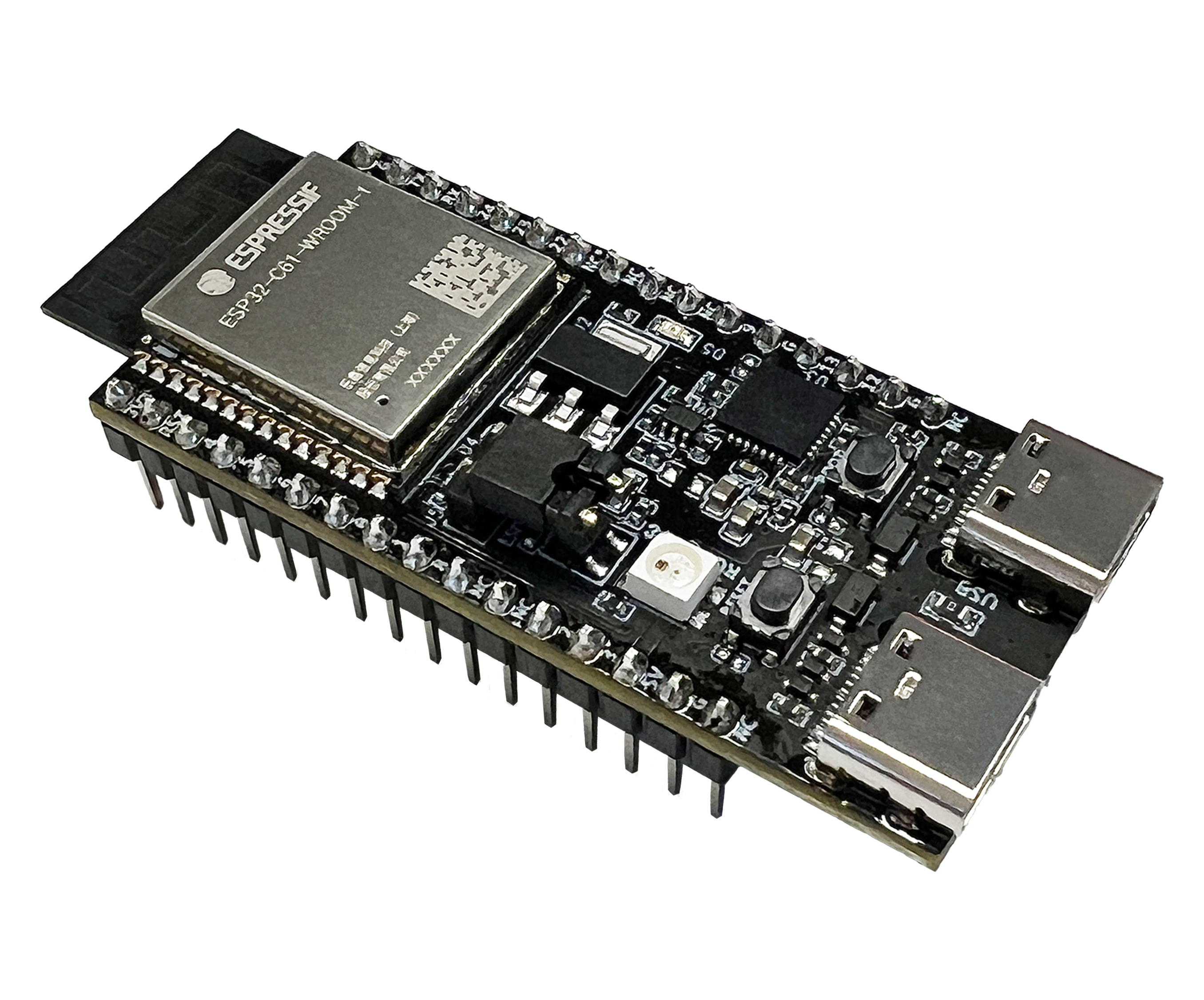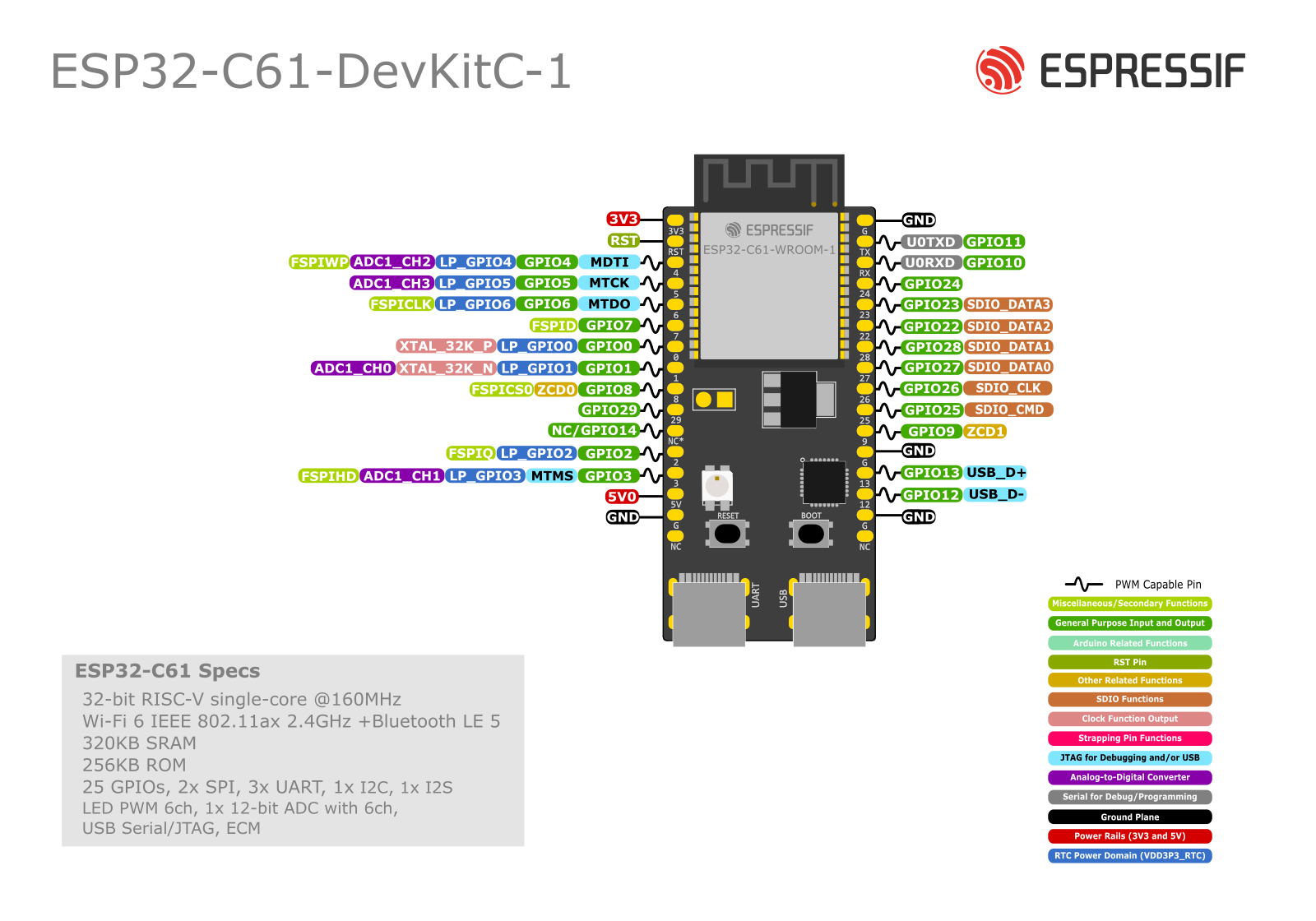ESP32-C61-DevKitC-1 v2.0
Older version: ESP32-C61-DevKitC-1 v1.0
This user guide will help you get started with ESP32-C61-DevKitC-1 and will also provide more in-depth information.
ESP32-C61-DevKitC-1 is an entry-level development board based on ESP32-C61-WROOM-1. The module integrated on this board comes with up to 8 MB of SPI flash and 2 MB of PSRAM. This board integrates complete Wi-Fi, and Bluetooth® Low Energy functions.
Most of the I/O pins are broken out to the pin headers on both sides for easy interfacing. Developers can either connect peripherals with jumper wires or mount ESP32-C61-DevKitC-1 on a breadboard.

ESP32-C61-DevKitC-1 (click to enlarge)
The document consists of the following major sections:
Getting Started: Overview of the board and hardware/software setup instructions to get started.
Hardware Reference: More detailed information about the board’s hardware.
Hardware Revision Details: Hardware revision history and known issues (if any) of the board.
Related Documents: Links to related documentation.
Getting Started
This section provides a brief introduction of ESP32-C61-DevKitC-1, instructions on how to do the initial hardware setup and how to flash firmware onto it.
Description of Components

ESP32-C61-DevKitC-1 - front
The key components of the board are described in a clockwise direction.
Key Component |
Description |
|---|---|
ESP32-C61-WROOM-1 |
ESP32-C61-WROOM-1 is a general-purpose module supporting Wi-Fi 6 in 2.4 GHz band and Bluetooth 5. Built around the ESP32-C61HR2 chip, this module comes with a PCB antenna and offers up to 8 MB SPI flash and 2 MB PSRAM. |
Pin Header |
All available GPIO pins (except for the SPI bus for flash and PSRAM) are broken out to the pin headers on the board. |
5 V to 3.3 V LDO |
Power regulator that converts a 5 V supply into a 3.3 V output. |
3.3 V Power On LED |
Turns on when the USB power is connected to the board. |
USB-to-UART Bridge |
Single USB-to-UART bridge chip provides transfer rates up to 3 Mbps. |
ESP32-C61 USB Type-C Port |
The USB Type-C port on the ESP32-C61 chip compliant with USB 2.0 full speed. It is capable of up to 12 Mbps transfer speed (Note that this port does not support the faster 480 Mbps high-speed transfer mode). This port is used for power supply to the board, for flashing applications to the chip, for communication with the chip using USB protocols, as well as for JTAG debugging. |
Boot Button |
Download button. Holding down Boot and then pressing Reset initiates Firmware Download mode for downloading firmware through the serial port. |
Reset Button |
Press this button to restart the system. |
USB Type-C to UART Port |
Used for power supply to the board, flashing applications to the chip, as well as communication with the ESP32-C61 chip via the on-board USB-to-UART bridge. |
RGB LED |
Addressable RGB LED, driven by GPIO8. |
J5 |
Used for current measurement. See details in Section Current Measurement. |
Start Application Development
Before powering up your board, please make sure that it is in good condition with no obvious signs of damage.
Required Hardware
ESP32-C61-DevKitC-1
USB-A to USB-C cable
Computer running Windows, Linux, or macOS
Note
Be sure to use a good quality USB cable. Some cables are for charging only and do not provide the needed data lines nor work for programming the boards.
Hardware Setup
Connect the board to your computer using the USB Type-C to UART Port. Connection using the ESP32-C61 USB Type-C Port is not fully implemented in software. In the subsequent steps, the USB Type-C to UART Port will be used by default.
Software Setup
Please proceed to ESP-IDF Get Started to set up the development environment and flash an application example onto your board.
Note
In most cases USB drivers required to operate the board are already included in Windows, Linux, and macOS operating systems. Some additional port access or security configuration may be required depending on your OS. In case of issues please check documentation on how to establish serial connection with the board. The documentation also includes links to USB drivers applicable to boards produced by Espressif.
Espressif provides Board Support Packages (BSPs) for various Espressif boards that help you initialize and use key onboard peripherals, such as LCD displays, audio chips, buttons, and LEDs, more easily and efficiently. For a complete list of supported boards, please visit esp-bsp.
Contents and Packaging
This section provides information about packaging and contents for retail and wholesale orders. The development board has a variety of variants to choose from. Please visit the ESP Product Selector, select the Development Board tab, and review the comprehensive list of available board variants.
Retail orders
If you order a few samples, each ESP32-C61-DevKitC-1 comes in an individual package in either antistatic bag or any packaging depending on your retailer.
For retail orders, please go to https://www.espressif.com/en/company/contact/buy-a-sample.
Wholesale Orders
If you order in bulk, the boards come in large cardboard boxes.
For wholesale orders, please go to https://www.espressif.com/en/contact-us/sales-questions.
Hardware Reference
Block Diagram
The block diagram below shows the components of ESP32-C61-DevKitC-1 and their interconnections.

ESP32-C61-DevKitC-1 (click to enlarge)
Power Supply Options
There are three mutually exclusive ways to provide power to the board:
USB Type-C to UART Port and ESP32-C61 USB Type-C Port (either one or both), default power supply (recommended)
5V and GND pin headers
3V3 and GND pin headers
Note
The board operates at a 5 V power supply and requires a minimum current of 0.5 A. If your application demands a current exceeding 0.5 A, consider connecting the board via a powered USB hub to ensure stable operation.
Current Measurement
The J5 headers on ESP32-C61-DevKitC-1 (see J5 in Figure ESP32-C61-DevKitC-1 - front) can be used for measuring the current drawn by the ESP32-C61-WROOM-1 module:
Remove the jumper: Power supply between the module and peripherals on the board is cut off. To measure the module’s current, connect the board with an ammeter via J5 headers.
Apply the jumper (factory default): Restore the board’s normal functionality.
Note
When using 3V3 and GND pin headers to power the board, please remove the J5 jumper, and connect an ammeter in series to the external circuit to measure the module’s current.
Header Block
The two tables below provide the Name and Function of the pin headers on both sides of the board (J1 and J3). The pin header names are shown in Figure ESP32-C61-DevKitC-1 - front. The numbering is the same as in the ESP32-C61-DevKitC-1 Schematic (PDF).
J1
No. |
Name |
Type 1 |
Function |
|---|---|---|---|
1 |
3V3 |
P |
3.3 V power supply |
2 |
RST |
I |
High: enables the chip; Low: disables the chip. |
3 |
4 |
I/O/T |
MTDI, GPIO4, LP_GPIO4, ADC1_CH2, FSPIWP |
4 |
5 |
I/O/T |
MTCK, GPIO5, LP_GPIO5, ADC1_CH3 |
5 |
6 |
I/O/T |
MTDO, GPIO6, LP_GPIO6, FSPICLK |
6 |
7 |
I/O/T |
GPIO7 3, FSPID |
7 |
0 |
I/O/T |
GPIO0, XTAL_32K_P, LP_GPIO0 |
8 |
1 |
I/O/T |
GPIO1, XTAL_32K_N, LP_GPIO1, ADC1_CH0 |
9 |
8 |
I/O/T |
|
10 |
29 |
I/O/T |
GPIO29 |
11 |
NC/14 |
I/O/T |
No connection/GPIO14 4 |
12 |
2 |
I/O/T |
GPIO2, LP_GPIO2, FSPIQ |
13 |
3 |
I/O/T |
MTMS, GPIO3, LP_GPIO3, ADC1_CH1, FSPIHD |
14 |
5V |
P |
5 V power supply |
15 |
G |
G |
Ground |
16 |
NC |
– |
No connection |
J3
No. |
Name |
Type |
Function |
|---|---|---|---|
1 |
G |
G |
Ground |
2 |
TX |
I/O/T |
U0TXD, GPIO11 |
3 |
RX |
I/O/T |
U0RXD, GPIO10 |
4 |
24 |
I/O/T |
GPIO24 |
5 |
23 |
I/O/T |
GPIO23, SDIO_DATA3 |
6 |
22 |
I/O/T |
GPIO22, SDIO_DATA2 |
7 |
28 |
I/O/T |
GPIO28, SDIO_DATA1 |
8 |
27 |
I/O/T |
GPIO27, SDIO_DATA0 |
9 |
26 |
I/O/T |
GPIO26, SDIO_CLK |
10 |
25 |
I/O/T |
GPIO25, SDIO_CMD |
11 |
9 |
I/O/T |
GPIO9 3, ZCD1 |
12 |
G |
G |
Ground |
13 |
13 |
I/O/T |
GPIO13, USB_D+ |
14 |
12 |
I/O/T |
GPIO12, USB_D- |
15 |
G |
G |
Ground |
16 |
NC |
– |
No connection |
- 1
P: Power supply; I: Input; O: Output; T: High impedance.
- 2
Used to drive the RGB LED.
- 3(1,2,3)
GPIO7, GPIO8, and GPIO9 are strapping pins of the ESP32-C61 chip. These pins are used to control several chip functions depending on binary voltage values applied to the pins during chip power-up or system reset. For description and application of the strapping pins, please refer to ESP32-C61 Datasheet > Section Boot Configurations.
- 4
For the module with integrated SPI PSRAM, this pin is already used as SPICS1 and cannot be used for other functions; for the module without integrated SPI PSRAM, this pin can be used as GPIO14.
Pin Layout

ESP32-C61-DevKitC-1 Pin Layout (click to enlarge)
Hardware Revision Details
Revision History
ESP32-C61-DevKitC-1 v2.0: For boards with the PW number of and after PW-2025-05-0781, J1 and J3 functions are updated. See details in Section Header Block.
ESP32-C61-DevKitC-1 v1.0 was the initial release.
Note
The PW number can be found in the product label on the large cardboard boxes for wholesale orders.